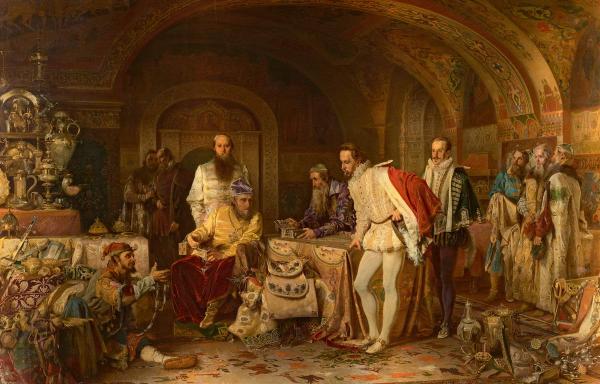The artist is Litovchenko

The English diplomat Jerome Gorsey (about 1550–1626) lived in Russia for almost two decades, working in the representative office of the English Moscow company. His pen belongs several works about Russia. In 1581, during the Livonian War, he took an important position at the Russian court, engaged in the supply of military supplies from England. The picture captures the episode from the last years of the reign of Ivan IV, marked by heavy inside and foreign policy failures. Wanting to demonstrate to the foreign diplomat his non -dead power, the king brought him under the arches of the Kremlin treasury.
Litovchenko was one of the artists, in the works of which the lack of picturesque temperament, and sometimes psychological persuasiveness, was redeemed by the unconditional reliability in the reconstruction of the historical situation. The picture is distinguished by a thorough and elegant manner of writing, tangiously conveying the texture of things – the gloss of stones and metal, the softness of silk and velvet. In colorful, the central part of the canvas is most interesting, in which the combination of golden, lilac, dark red tones of the costumes of Ivan and Gorsey creates a feeling of luxury. (E. Sh.)
Electronic catalog “Heroes and villains of Russian history”. SPb, 2010. With. 115.
Tsar Ivan IV Vasilievich (Grozny) (1530-1584) – son of Vasily III and Elena Glinskaya. Ventchans to the kingdom in 1547 after the short regenantance of the mother and the reign of the boyars. The same date is considered the beginning of the formation of the Moscow Kingdom (1547-1721), when John IV Vasilyevich during the coronation adopted the title of “king of all Rus'”. Thus, he asserted himself as a sovereign ruler and heir to the Byzantine emperors (John was the grandson of Sofia Paleolog, niece of the last emperor Byzantium). However, the claims of the great Moscow princes to the royal title are still traced from Ivan III, when many rituals and symbols were borrowed from Byzantium.
Approximately the same time, the birth of the concept of Moscow is the Third Rome, which affirmed the Messianic role of Russia as the main stronghold of Orthodoxy. In the 1550s he carried out a number of reforms with the participation of a narrow circle of close people-the elected Rada. At this time, a all -Russian judiciary was published, an ordered management system was improved, a permanent arrow of Sagittarius was created, the Stopatical Council (1551) was convened for unifying church rites and resolving the issues of canonization, a service on service, which established the obligation for landowners to be “Conno, crowded and crowded, is crowded and weapon “.
Implemented a number of successful campaigns on the accession of Khanates – Kazan (1552) and Astrakhan (1556), as well as Bashkiria (1557). Was defeated in the Livonian war for going to the Baltic Sea (1558-1583). Due to the policy he was faced with opposition boyar circles, which led to the introduction of oprichnina and political conspiracies (1567 and 1569). Patronized the development of culture, church construction and education. “Formidable” Ivan IV was nicknamed the people for the execution of political traitors.
Leave a Reply